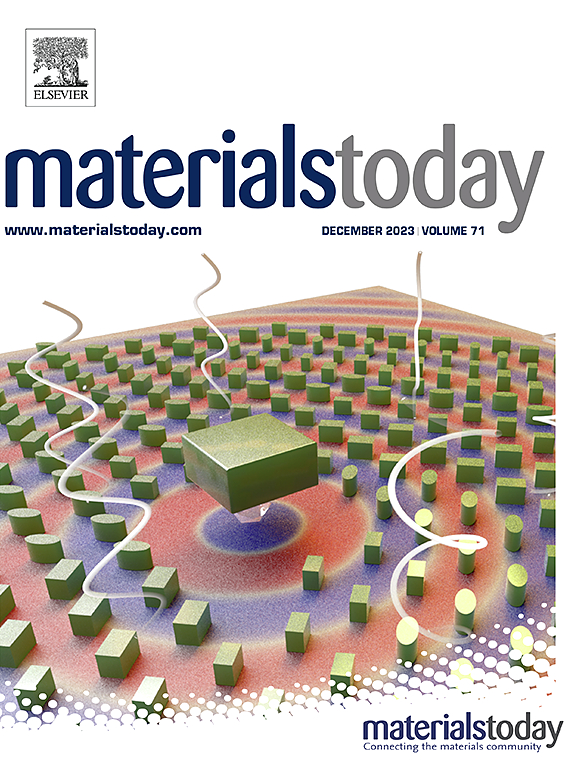用于快速柔性电子的大规模超薄导电二维金属薄膜(<3.5 nm)
IF 21.1
1区 材料科学
Q1 MATERIALS SCIENCE, MULTIDISCIPLINARY
引用次数: 0
摘要
将二维(2D)金属薄膜的厚度推至10 nm以下意味着更高的透明度和更好的柔韧性,这将有助于提高基于二维金属的柔性电子器件的响应灵敏度。然而,由于传统固体衬底上的岛状结构生长机制,二维金属薄膜容易发生晶格畸变和空洞裂纹,大大削弱了超薄二维金属薄膜的透明度和导电性。在这里,我们创新地提出了一种气液界面沉积(ALID)方法来解决这一难题,该方法将具有连续导电性的超薄2D金属薄膜沉积在液体衬底上。由于液体衬底的浅注入和布朗运动,通过上述方法获得了尺寸达φ 90 mm × 3.5 nm的二维金属(Au, Ag, Cu, Bi, Pt等)薄膜,并且在5 s内连续导电。更重要的是,与传统气固界面沉积方法制备的金属膜相比,通过ALID制备的金属膜具有更低的表面粗糙度(0.207 nm),更好的透明度(85%),并且由于金属原子可以几乎自由地排列在各向异性的液体表面上,因此具有更强的耐磨性。此外,基于这些二维金属薄膜制成的电阻传感器可以实现弯曲、撞击和拉伸等柔性传感运动,响应时间超快(t = 60 ms),响应灵敏度高(△R/R0 = 800%)。一方面为超薄连续导电薄膜的大规模制备提供了新的解决方案,另一方面丰富了薄膜在液体表面的生长机理。本文章由计算机程序翻译,如有差异,请以英文原文为准。
Large scale and ultra-thin conductive two-dimensional metal films (<3.5 nm) for fast flexible electronics
Pushing the thickness of two-dimensional (2D) metal films to below 10 nm means higher transparency and better flexibility, which will help improve the response sensitivity of flexible electronic devices based on 2D metals. However, lattice distortion and void cracks are facile occurred in the 2D metal film due to the island structure growth mechanism on the traditional solid substrates, which greatly weakens the transparency and conductivity of ultra-thin 2D metal films. Here, we innovatively proposed an air–liquid interface deposition (ALID) method to address this dilemma, in which ultrathin 2D metal films with continuous conductivity were deposited on liquid substrates. Thanks to the shallow injection and the Brownian motion of the liquid substrate, 2D metal (Au, Ag, Cu, Bi, Pt, etc.) films with dimensions up to φ 90 mm × 3.5 nm were obtained through the above method with continuous conductivity in only 5 s. More importantly, compared with the metal film prepared by traditional air–solid interface deposition method, the metal film prepared through ALID has lower surface roughness (0.207 nm), better transparency (85 %), and stronger wear resistance since metal atoms can be arranged almost freely on the isotropic liquid surface. Furthermore, the fabricated resistance sensor based on these 2D metal films can realize flexible sensing such as bending, hitting and stretching motions with ultrafast response time (t = 60 ms) and robust response sensitivity (△R/R0 = 800 %). On the one hand, it provides a new solution for the large scale preparation of ultra-thin continuous conductive films, and on the other hand, it enriches the growth mechanism of thin films on the liquid surface.
求助全文
通过发布文献求助,成功后即可免费获取论文全文。
去求助
来源期刊

Materials Today
工程技术-材料科学:综合
CiteScore
36.30
自引率
1.20%
发文量
237
审稿时长
23 days
期刊介绍:
Materials Today is the leading journal in the Materials Today family, focusing on the latest and most impactful work in the materials science community. With a reputation for excellence in news and reviews, the journal has now expanded its coverage to include original research and aims to be at the forefront of the field.
We welcome comprehensive articles, short communications, and review articles from established leaders in the rapidly evolving fields of materials science and related disciplines. We strive to provide authors with rigorous peer review, fast publication, and maximum exposure for their work. While we only accept the most significant manuscripts, our speedy evaluation process ensures that there are no unnecessary publication delays.
 求助内容:
求助内容: 应助结果提醒方式:
应助结果提醒方式:


